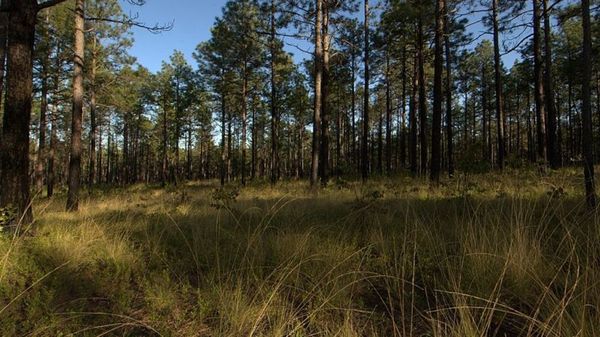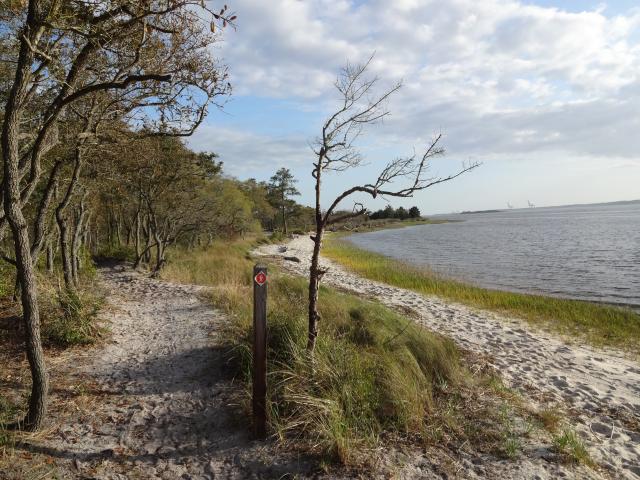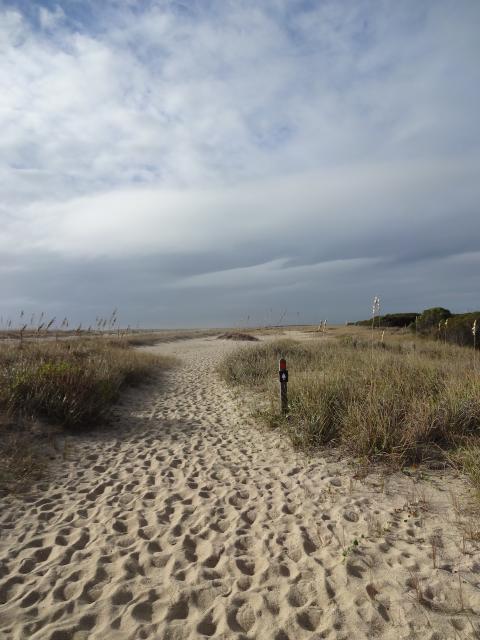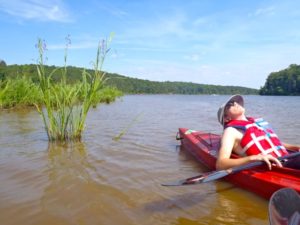On our weekly Tuesday Night Hike this past week we lingered at hike’s end to take in the three-quarternmoon that lit the tree-lined parking area. While our 3-mile night hike on the Mountains-to-Sea Trail was pretty great, we might have been just as content to hang out in the lot and bask in the moonlight. Imagine, I thought, being under a full moon and in an area with even more exposure.
Tag Archives: Jockey’s Ridge
GetOut! A good weekend to go coastal
Three hikes this Saturday at the coast catch my eye for several reasons. Mainly, though, because they celebrate the coast in a season when it most deserves to be celebrated.
True, most of us think of the coast mostly in summer, when it comes time for the annual week-long beach vacation, a time for heat, sun, surf and crowds.
GetOut! A good forecast and lots to do at the coast
If you checked in with us Wednesday — “Coastal Trails Beckon for Winter Hiking” — you know that as the temperatures drop our interest in exploring the coast and coastal plain rises. With that in mind, some thoughts on this weekend.
Soundside Nature Trail Hike, Saturday, Nov. 13, 10 a.m., Jockey’s Ridge State Park, Nags Head. Think of Jockey’s Ridge and you immediately think of the shifting dunes that can reach up to 60 feet above the level of the sea, which is a near stone’s throw from the park. But Jockey’s Ridge has intriguing backside that explores a maritime shrub thicket along Roanoke Sound. This is a 1-mile hike. Learn more here.
Resources for a steamy weekend of cool, wet fun
We’re staring down the first steamy weekend of the summer. Frankly, I’m hard pressed to think of something to do outdoors that doesn’t involve water.
There’s swimming, of course. At your local pool (search for local parks and rec departments with pools at the North Carolina Recreation & Parks Association Web site), at a trusted swimming hole (find 76 in North Carolina at SwimmingHoles.org), at the coast (find Outer Banks beaches here, Wilmington area beaches here and assorted other beaches here.
Options considered for coastal Mountains-to-Sea Trail

My idea of a good time when I can’t be outdoors?
Sitting around a big conference table with the head of the state’s largest trail system and a newly minted map.
Wednesday, Kate Dixon, executive director of the Friends of the Mountains-to-Sea Trail attended a meeting in New Bern about the path the MST would take from New Bern to the Outer Banks. Thursday, she took a few minutes to update me the latest developments on the statewide trail, a 1,000-mile work in progress that will one day run from atop Clingman’s Dome on the Tennessee border across the Tar Heel state to Jockey’s Ridge at the lip of the Atlantic.
A little over half of the trail is done. There’s a 300-mile continuous stretch in the mountains, mostly along the Blue Ridge Parkway, and another good chunk through the Triangle. East of Clayton, though, there’s a long dry spell before you reach the MST’s exciting conclusion along the coast. It was that dry spell that Dixon wanted to talk about.
Specifically, the meeting a day earlier had been about routing the MST through the coastal Croatan National Forest, from New Bern east to the Outer Banks.
“The problem with the Croatan,” she said, “is that it’s wet.”
Indeed. You can’t go far in the 160,000-acre national forest before you run into a wet area known as a pocosin, or upland swamp. Dixon traced her index finger across a number of old roadbeds that seemed to penetrate the forest. Alas, her finger would stop in a pocosin or simply disappear into the mass of coastal jungle growth. Another option, which the FMST isn’t crazy about, is piggybacking on a US 70 bypass around Havelock. Not a lot of esthetic reward in hiking alongside a divided four-lane highway.
Dixon threw a curve ball, though, when she pointed out a sparsely used rail line that runs between the Cherry Point Marine facility near Havelock to Camp LeJeune in Jacksonville, a path roughly perpendicular to a trail coming down the Neuse River. A trail paralleling the Neuse has long been considered the route the MST would take through the coastal plain. The rail line came nowhere close to the Neuse.
“How would that work?” I asked.
“We’re thinking about three types of routes to the coast,” Dixon said.
One would be a paddle route, down the Neuse, to New Bern. Another would be a bike route, following the Neuse as close as possible on less-traveled country roads and passing through the Neuse communities of Goldsboro, Kinston and New Bern. The hiking trail would follow a southerly route, parting ways with the Neuse at Smithfield.
Running a hiking trail along the coastal Neuse is proving problematic on several fronts, Dixon said. In spots, especially in the Let’Lones area below Smithfield, the land is perpetually wet. That’s a problem because the public corridor along the Neuse is only 50 feet wide and much of the surrounding land is privately owned,much of it by folks who have been slow to warm to a public trail running across their property.
So instead, the FMST is looking at dropping the hiking trail south of Smithfield to Bentonville and on to the Bladen Lakes area east of Fayetteville. There, it would make its way east to Jacksonville and pick up the aforementioned rail line, where they might be able to strike an access arrangement. The trail would then tap into the Croatan’s Neusiok Trail and head east to the Outer Banks. Another advantage to the southerly route: there’s more public land to run the trail through.
“It’s just something we’ve started looking at,” says Dixon.



